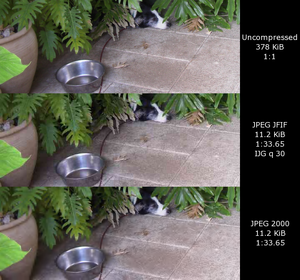
Back JPEG 2000 Catalan JPEG 2000 Czech JPEG 2000 German JPEG 2000 Spanish JPEG 2000 Persian JPEG 2000 Finnish JPEG 2000 French JPEG 2000 Italian JPEG 2000 Japanese JPEG 2000 Korean
This article's use of external links may not follow Wikipedia's policies or guidelines. (January 2021) |
 | |
 Comparison of JPEG 2000 with the original JPEG format | |
| Filename extension | .jp2, .j2k, .jpf, .jpm, .jpg2, .j2c, .jpc, .jpx, .mj2 |
|---|---|
| Internet media type | image/jp2, image/jpx, image/jpm, video/mj2 |
| Uniform Type Identifier (UTI) | public.jpeg-2000 |
| Magic number | 00 00 00 0C 6A 50 20 20 0D 0A 87 0A / FF 4F FF 51 |
| Developed by | Joint Photographic Experts Group |
| Type of format | Graphics file format |
| Extended from | JPEG |
| Standard | ISO/IEC 15444 |
| Open format? | Yes |
| Free format? | See § Legal status |
| Website | jpeg |
JPEG 2000 (JP2) is an image compression standard and coding system. It was developed from 1997 to 2000 by a Joint Photographic Experts Group committee chaired by Touradj Ebrahimi (later the JPEG president),[1] with the intention of superseding their original JPEG standard (created in 1992), which is based on a discrete cosine transform (DCT), with a newly designed, wavelet-based method. The standardized filename extension is .jp2 for ISO/IEC 15444-1 conforming files and .jpx for the extended part-2 specifications, published as ISO/IEC 15444-2. The registered MIME types are defined in RFC 3745.[2] For ISO/IEC 15444-1 it is image/jp2.
The JPEG 2000 project was motivated by Ricoh's submission in 1995 of the CREW (Compression with Reversible Embedded Wavelets) algorithm[3][4] to the standardization effort of JPEG-LS. Ultimately the LOCO-I algorithm was selected as the basis for JPEG-LS, but many of the features of CREW ended up in the JPEG 2000 standard.[5]
JPEG 2000 codestreams are regions of interest that offer several mechanisms to support spatial random access or region of interest access at varying degrees of granularity. It is possible to store different parts of the same picture using different quality.
JPEG 2000 is a compression standard based on a discrete wavelet transform (DWT). The standard could be adapted for motion imaging video compression with the Motion JPEG 2000 extension. JPEG 2000 technology was selected as the video coding standard for digital cinema in 2004.[6] However, JPEG 2000 is not supported in web browsers (the main exceptions being WebKit-based browsers such as Safari) for web pages as of 2022,[update] and hence is not generally used on the World Wide Web. Nevertheless, for those with PDF support, web browsers generally support JPEG 2000 in PDFs.
- ^ Taubman, David; Marcellin, Michael (2012). JPEG2000 Image Compression Fundamentals, Standards and Practice: Image Compression Fundamentals, Standards and Practice. Springer Science & Business Media. ISBN 9781461507994.
- ^ Clark, Richard; Lee, Daniel T.; Singer, David (April 2004). "RFC 3745: MIME Type Registrations for JPEG 2000 (ISO/IEC 15444)". IETF Datatracker. Internet Engineering Task Force. Retrieved 21 April 2024.
- ^ Zandi, A.; Allen, J.D.; Schwartz, E.L.; Boliek, M. (1995). CREW: Compression with Reversible Embedded Wavelets. IEEE Comput. Soc. Press. pp. 212–221. doi:10.1109/DCC.1995.515511. ISBN 978-0-8186-7012-1.
- ^ Boliek, Martin P.; Gormisch, Michael J.; Schwartz, Edward L.; Keith, Alexander F. (July 1998). "Decoding compression with reversible embedded wavelets (CREW) codestreams". Journal of Electronic Imaging. 7 (3): 402–409. Bibcode:1998JEI.....7..402B. doi:10.1117/1.482653. ISSN 1017-9909.
- ^ Marcellin, M.W.; Gormish, M.J.; Bilgin, A.; Boliek, M.P. (2000). An overview of JPEG-2000. IEEE Comput. Soc. pp. 523–541. doi:10.1109/DCC.2000.838192. ISBN 978-0-7695-0592-3.
- ^ Swartz, Charles S. (2005). Understanding Digital Cinema: A Professional Handbook. Taylor & Francis. p. 147. ISBN 9780240806174.
© MMXXIII Rich X Search. We shall prevail. All rights reserved. Rich X Search